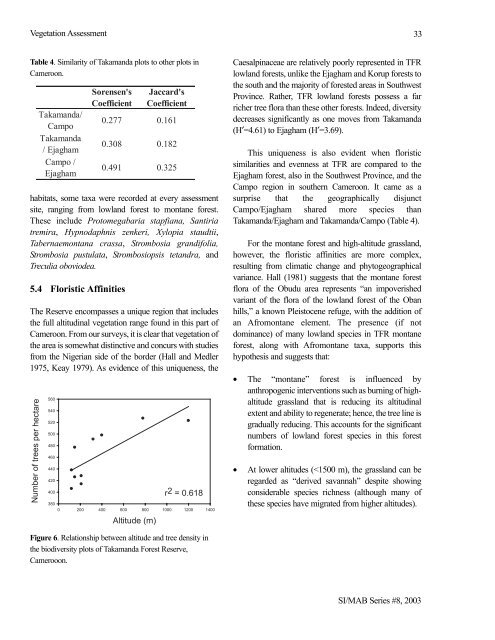Fisheries in the Southern Border Zone of Takamanda - Impact ...
Fisheries in the Southern Border Zone of Takamanda - Impact ...
Fisheries in the Southern Border Zone of Takamanda - Impact ...
You also want an ePaper? Increase the reach of your titles
YUMPU automatically turns print PDFs into web optimized ePapers that Google loves.
Vegetation Assessment<br />
Table 4. Similarity <strong>of</strong> <strong>Takamanda</strong> plots to o<strong>the</strong>r plots <strong>in</strong><br />
Cameroon.<br />
habitats, some taxa were recorded at every assessment<br />
site, rang<strong>in</strong>g from lowland forest to montane forest.<br />
These <strong>in</strong>clude Protomegabaria stapfiana, Santiria<br />
tremira, Hypnodaphnis zenkeri, Xylopia staudtii,<br />
Tabernaemontana crassa, Strombosia grandifolia,<br />
Strombosia pustulata, Strombosiopsis tetandra, and<br />
Treculia oboviodea.<br />
5.4 Floristic Aff<strong>in</strong>ities<br />
The Reserve encompasses a unique region that <strong>in</strong>cludes<br />
<strong>the</strong> full altitud<strong>in</strong>al vegetation range found <strong>in</strong> this part <strong>of</strong><br />
Cameroon. From our surveys, it is clear that vegetation <strong>of</strong><br />
<strong>the</strong> area is somewhat dist<strong>in</strong>ctive and concurs with studies<br />
from <strong>the</strong> Nigerian side <strong>of</strong> <strong>the</strong> border (Hall and Medler<br />
1975, Keay 1979). As evidence <strong>of</strong> this uniqueness, <strong>the</strong><br />
Number <strong>of</strong> trees per hectare<br />
<strong>Takamanda</strong>/<br />
Campo<br />
<strong>Takamanda</strong><br />
/ Ejagham<br />
Campo /<br />
Ejagham<br />
560<br />
540<br />
520<br />
500<br />
480<br />
460<br />
440<br />
420<br />
400<br />
Sorensen©s<br />
Coefficient<br />
Jaccard©s<br />
Coefficient<br />
0.277 0.161<br />
0.308 0.182<br />
0.491 0.325<br />
380<br />
0 200 400 600 800 1000 1200 1400<br />
Altitude (m)<br />
r2 = 0.618<br />
Figure 6. Relationship between altitude and tree density <strong>in</strong><br />
<strong>the</strong> biodiversity plots <strong>of</strong> <strong>Takamanda</strong> Forest Reserve,<br />
Camerooon.<br />
Caesalp<strong>in</strong>aceae are relatively poorly represented <strong>in</strong> TFR<br />
lowland forests, unlike <strong>the</strong> Ejagham and Korup forests to<br />
<strong>the</strong> south and <strong>the</strong> majority <strong>of</strong> forested areas <strong>in</strong> Southwest<br />
Prov<strong>in</strong>ce. Ra<strong>the</strong>r, TFR lowland forests possess a far<br />
richer tree flora than <strong>the</strong>se o<strong>the</strong>r forests. Indeed, diversity<br />
decreases significantly as one moves from <strong>Takamanda</strong><br />
(H′=4.61) to Ejagham (H′=3.69).<br />
This uniqueness is also evident when floristic<br />
similarities and evenness at TFR are compared to <strong>the</strong><br />
Ejagham forest, also <strong>in</strong> <strong>the</strong> Southwest Prov<strong>in</strong>ce, and <strong>the</strong><br />
Campo region <strong>in</strong> sou<strong>the</strong>rn Cameroon. It came as a<br />
surprise that <strong>the</strong> geographically disjunct<br />
Campo/Ejagham shared more species than<br />
<strong>Takamanda</strong>/Ejagham and <strong>Takamanda</strong>/Campo (Table 4).<br />
For <strong>the</strong> montane forest and high-altitude grassland,<br />
however, <strong>the</strong> floristic aff<strong>in</strong>ities are more complex,<br />
result<strong>in</strong>g from climatic change and phytogeographical<br />
variance. Hall (1981) suggests that <strong>the</strong> montane forest<br />
flora <strong>of</strong> <strong>the</strong> Obudu area represents “an impoverished<br />
variant <strong>of</strong> <strong>the</strong> flora <strong>of</strong> <strong>the</strong> lowland forest <strong>of</strong> <strong>the</strong> Oban<br />
hills,” a known Pleistocene refuge, with <strong>the</strong> addition <strong>of</strong><br />
an Afromontane element. The presence (if not<br />
dom<strong>in</strong>ance) <strong>of</strong> many lowland species <strong>in</strong> TFR montane<br />
forest, along with Afromontane taxa, supports this<br />
hypo<strong>the</strong>sis and suggests that:<br />
• The “montane” forest is <strong>in</strong>fluenced by<br />
anthropogenic <strong>in</strong>terventions such as burn<strong>in</strong>g <strong>of</strong> highaltitude<br />
grassland that is reduc<strong>in</strong>g its altitud<strong>in</strong>al<br />
extent and ability to regenerate; hence, <strong>the</strong> tree l<strong>in</strong>e is<br />
gradually reduc<strong>in</strong>g. This accounts for <strong>the</strong> significant<br />
numbers <strong>of</strong> lowland forest species <strong>in</strong> this forest<br />
formation.<br />
• At lower altitudes (

















